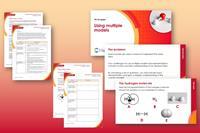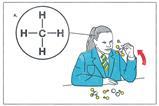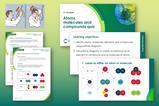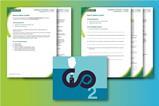Improve your learners’ skills interpreting and evaluating models
This resource accompanies the article A model approach to solving problems, part of the Teaching science skills series in Education in Chemistry.
The questions used in the activity are based on the Focus, Action and Reflection (FAR) approach, outlined in Reflect on your use of models. There you will find a checklist you can use to reflect on the models you choose to use in your teaching.
Learning objectives
- Use a variety of models to develop scientific understanding of a molecule of hydrogen.
- Discuss limitations of models in science.
The student worksheet contains five different models representing a hydrogen molecule. The questions will guide learners to evaluate each model.
How to use the resource
This resource could be used after you have taught covalent bonding, as a scientific skills lesson, or a revision lesson.
It starts off as a whole class activity by introducing the problem of multiple models.
Ensure key fundamentals are secure, such as the definitions of ‘atom’, ‘molecule’ and ‘bond’: this Atoms, molecules and compounds quiz provides useful starter questions.
Learners then work independently, evaluating each model using their worksheet. There is an opportunity (slide four) for peer discussion if this would fit the needs of the class. Slide five offers a chance for self-assessment, with some possible answers. Question six is a challenging question; asking learners not only to reflect, but to improve.

This article is part of our Teaching science skills series, bringing together strategies and classroom activities to help your learners develop essential scientific skills, from literacy to risk assessment and more.
Differentiation
Support learners with their evaluation by guiding them with questions. For example, what does the two in model B represent? How is that represented in the other models? Or ask them to begin by comparing just two of the models, eg C and H. Learners can support each other by discussing their answers.
Extension questions may be asked if learners want more challenge, such as applying the five models (A–E) to a different molecule, and then compound.
Answers
Some likely answers to questions one–four are given in the teacher notes, key points are summarised on slide five for learners to self-assess. Note: learners may have questions when self-assessing, as their answers may be similar but not worded in the exact same way. This opens up discussion about mark schemes and use of key words.
Be aware of common misconceptions surrounding covalent bonding in learners at this stage. How to teach covalent bonding gives an overview and advice on how to address them.
More resources
- How to draw dot and cross diagrams, infographic and resource, will give learners a chance to apply their understanding of representations of covalent bonding.
- Reflect on misconceptions and try these formula cards to model chemical reactions.
- Find out how to use post-16 models to inform 14–16 understanding.
- Show your students how models can help to predict reactions and influence the taste and texture of chocolate and biscuits, by sharing a profile of food scientist, Robert.
Downloads
Use multiple models - classroom slides
Presentation | PowerPoint, Size 0.45 mbUse multiple models - classroom slides
Presentation | PDF, Size 0.52 mbUse multiple models - teacher notes
Handout | PDF, Size 0.15 mbUse multiple models - teacher notes
Editable handout | Word, Size 0.42 mbUse multiple models - student sheet
Handout | PDF, Size 0.22 mbUse multiple models - student sheet
Editable handout | Word, Size 0.49 mb
























No comments yet